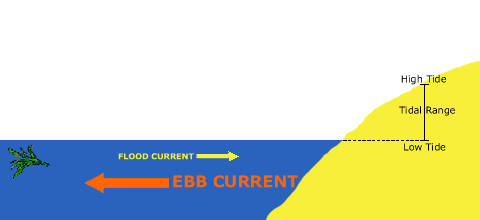Tides and Water Levels
What are Tides?
Tides are one of the most reliable phenomena in the world. As the sun rises in the east and the stars come out at night, we are confident that the ocean waters will regularly rise and fall along our shores. The following pages describe the tremendous forces that cause the world’s tides, and why it is important for us to understand how they work.

This animation shows the relationship between the vertical and horizontal components of tides. As the tide rises, water moves toward the shore. This is called a flood current. As the tide recedes, the waters move away from the shore. This is called an ebb current. The movement of water toward and away from the shore is illustrated by the movement of the green seaweed.
Basically, tides are very long-period waves that move through the oceans in response to the forces exerted by the moon and sun. Tides originate in the oceans and progress toward the coastlines where they appear as the regular rise and fall of the sea surface. When the highest part, or crest of the wave reaches a particular location, high tide occurs; low tide corresponds to the lowest part of the wave, or its trough. The difference in height between the high tide and the low tide is called the tidal range.
A horizontal movement of water often accompanies the rising and falling of the tide. This is called the tidal current. The incoming tide along the coast and into the bays and estuaries is called a flood current; the outgoing tide is called an ebb current. The strongest flood and ebb currents usually occur before or near the time of the high and low tides. The weakest currents occur between the flood and ebb currents and are called "slack water" or "slack current". In the open ocean tidal currents are relatively weak. Near estuary entrances, narrow straits and inlets, the speed of tidal currents can reach up to several kilometers per hour.
Tides and Water Levels
